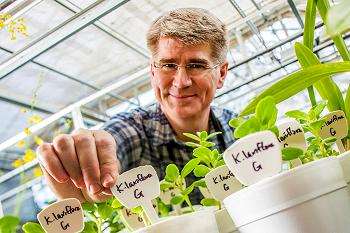The unassuming ice plant could become an ingenious weapon in the fight against a warming climate that threatens to limit regions suitable for growing biofuel crops. Biochemist and molecular biologist John Cushman at the University of Nevada, Reno will create a gene atlas for the common ice plant that will help find ways to allow bioenergy feedstocks to better tolerate salinity and drought.
Cushman's lab is looking at the functional genomics of crassulacean acid metabolism, or CAM, a water-conserving photosynthetic pathway that helps plants survive in seasonally arid climates or those with intermittent water supply. The Joint Genome Institute chose Cushman's research with the ice plant as one of 37 projects in their Community Science Program. The Institute holds a yearly Community Science Program competition among researchers who are exploring solutions to energy and environmental challenges.
"The goal of the plant flagship genome program is basically to create gene atlases for a series of target crops that are important to the DOE (Department of Energy) mission as bioenergy feedstocks," Cushman said. "But these selected species also include model plants that grow rapidly and are easy to study to improve our understanding of gene function."
The research objectives for Cushman's lab are to understand how environmental stress and the circadian clock control the expression of CAM. Members of the lab conduct integrated transcriptome, proteome, and metabolome analyses using the ice plant, which can survive under extremely harsh environmental conditions.
"It's simple really," Cushman said. "We release carbon dioxide and other greenhouse gases into the atmosphere and average temperatures around the world increase. More heat leads to greater soil drying and more water loss from plants so that they can stay cool, both of which lead to greater probability of drought stress. So, one of the predictions of global warming is that with all of this heating, we are going to need to develop more drought-tolerant plants in the very near future."
Ice plant, which originated in the Namibian desert of Africa, is important as the first reported plant species that could be induced to switch from C3 photosynthesis (which occurs during the day) to CAM photosynthesis (which occurs at night) following salinity stress or water-deficit treatment. CAM plants are five to six times more water-use efficient than C3 photosynthesis plants.
"We will catalog patterns of gene expression to know exactly which genes are important for doing CAM, and that's why the ice plant is such an important model, and that's why the DOE is interested in it," Cushman said. "So now, we can take those genes and reengineer them back to a C3 photosynthesis plant like wheat or rice, or a woody bioenergy feedstock like poplar, and we hope to make those more water-use efficient."
Cushman's project is ongoing, and he said that it would take several more years to completely understand how these plants tolerate drought and heat, and what the research could contribute to improving biofuels and also food crop security. The project's partnership with the Joint Genome Institute will provide access to state-of-the-art resources and facilities for his lab to continue this research.
"These new CSP projects, selected through our external review process, exploit JGI's experimental and analytical 'omics' capabilities and build our portfolio in key focus areas including sustainable bioenergy production, plant microbiomes and terrestrial biogeochemistry," Susannah Tringe, DOE JGI User Programs Deputy, said in the announcement of the 2017 Community Science Portfolio.

"Our project, and the CSP project of our collaborators at the Oak Ridge National Laboratories, and the Universities of Liverpool and Newcastle in the UK, on another model CAM species called Kalanchoe, is to understand CAM," says Cushman. "CAM is present in more than six percent of all vascular plant species across 36 different plant families, so it is a fairly widespread ecological adaptation"
Cushman received his bachelor's degree from Ursinus College in Collegeville, Pennsylvania, and his master's and doctorate degrees from Rutgers University, New Brunswick, New Jersey. He has been at the University of Nevada, Reno since 2000, is a Foundation Professor in the College of Agriculture, Biotechnology and Natural Resources and serves as the director of the Biochemistry Graduate Program. He has been named 2017 Researcher of the Year by the Nevada System of Higher Education.
Click here to see more...